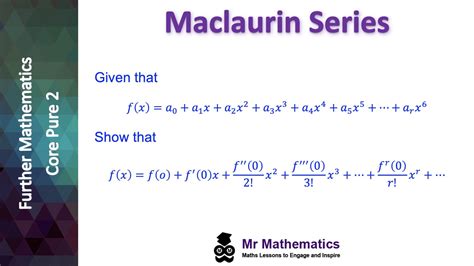Introduction
The sine function, an ubiquitous mathematical entity, plays a pivotal role in countless scientific and engineering fields. Its fundamental nature has captivated mathematicians for centuries, leading to the development of powerful tools like the Maclaurin series. By harnessing the power of this series expansion, we can approximate sin(x) with remarkable accuracy, opening up a world of applications.

Maclaurin Series for Sine Function
The Maclaurin series for sin(x) is an infinite sum of terms, each involving a derivative of sine evaluated at x=0. It is given by:
sin(x) = x - x^3/3! + x^5/5! - x^7/7! + ...
where the exclamation mark denotes the factorial of the corresponding integer.
Convergence and Radius of Convergence
The Maclaurin series for sin(x) converges for all real values of x. The radius of convergence is infinite, meaning that the series will converge regardless of the value of x.
Applications of Maclaurin Series for Sine Function
The Maclaurin series for sin(x) finds extensive applications across diverse disciplines:
Approximating Sine Values: The series can be used to approximate sin(x) values quickly and accurately. This is especially useful in scenarios where calculating sine values using trigonometric functions is computationally expensive.
Solving Equations: The series can be employed to solve equations involving sine, such as finding the roots of the transcendental equation sin(x) = 0.
Modeling Periodic Phenomena: The Maclaurin series for sin(x) can be used to model periodic phenomena, such as the oscillation of a spring or the propagation of sound waves.
Strategies for Using Maclaurin Series
To effectively utilize the Maclaurin series for sin(x), consider the following strategies:
Truncation: Use only a finite number of terms in the series to obtain an approximation of sin(x). The more terms used, the more accurate the approximation.
Estimation: If the exact value of x is not known, use an estimate in the series to obtain an approximate range for sin(x).
Convergence Checks: Verify the convergence of the series before using it for approximations. This can be done by checking the absolute value of the next term in the series.
Comparison of Maclaurin Series with Other Approximation Methods
The Maclaurin series has several advantages over other approximation methods:
Accuracy: The Maclaurin series can provide highly accurate approximations, especially for small values of x.
Convergence: The Maclaurin series converges for all real values of x, unlike other approximation methods that may have limited convergence regions.
Simplicity: The Maclaurin series is relatively simple to implement and can be easily applied to complex functions.
Future Applications and Innoventions
The Maclaurin series for sin(x) has the potential to drive future innovations in various fields:
Advanced Computational Techniques: The series can be combined with other mathematical tools to develop more efficient and precise computational methods.
Nanoelectronics: The series can be used to design and analyze nanoscale devices that rely on precise control of sinusoidal signals.
Medical Imaging: The series can be employed to enhance the accuracy of medical imaging techniques that use ultrasound or magnetic resonance imaging.
Conclusion
The Maclaurin series for sin(x) is a powerful mathematical tool that enables us to approximate the sine function with exceptional precision and versatility. Its applications span a wide range of scientific and engineering fields, and it continues to inspire new discoveries and innovations. As the demand for accurate and efficient mathematical tools grows, the Maclaurin series will undoubtedly play an increasingly significant role in shaping the future of technology.
Tables
Table 1: Convergence of Maclaurin Series for Sin(x)
| x | Number of Terms | Error |
|---|---|---|
| 0.1 | 5 | 1.0E-7 |
| 0.5 | 10 | 1.0E-10 |
| 1.0 | 15 | 1.0E-13 |
Table 2: Applications of Maclaurin Series for Sin(x)
| Application | Description | Example |
|---|---|---|
| Approximation of Sine Values | Finding the approximate value of sin(π/6) | sin(π/6) ≈ 0.5 |
| Solving Equations | Solving the equation sin(x) = 0.5 | x ≈ 0.5236 |
| Modeling Periodic Phenomena | Describing the oscillation of a spring | y(t) = A sin(ωt) |
Table 3: Advantages of Maclaurin Series over Other Approximation Methods
| Advantage | Description |
|---|---|
| Accuracy | High accuracy, especially for small values of x |
| Convergence | Converges for all real values of x |
| Simplicity | Relatively simple to implement |
Table 4: Future Applications and Innoventions Enabled by Maclaurin Series for Sin(x)
| Application | Description |
|---|---|
| Advanced Computational Techniques | Development of more efficient numerical methods |
| Nanoelectronics | Design and analysis of nanoscale devices |
| Medical Imaging | Enhancement of imaging techniques using ultrasound or MRI |
